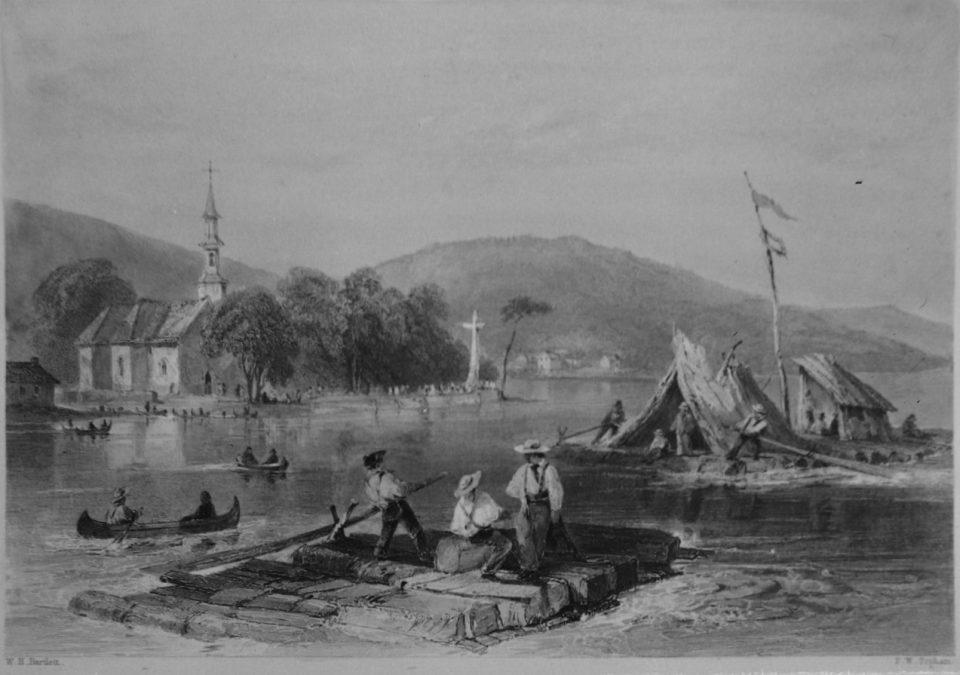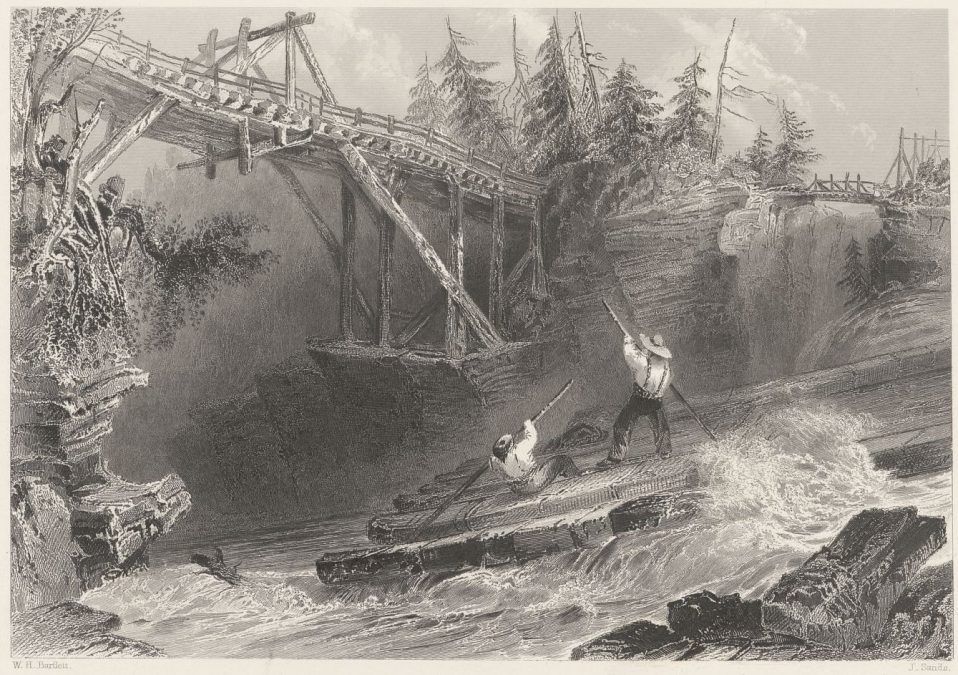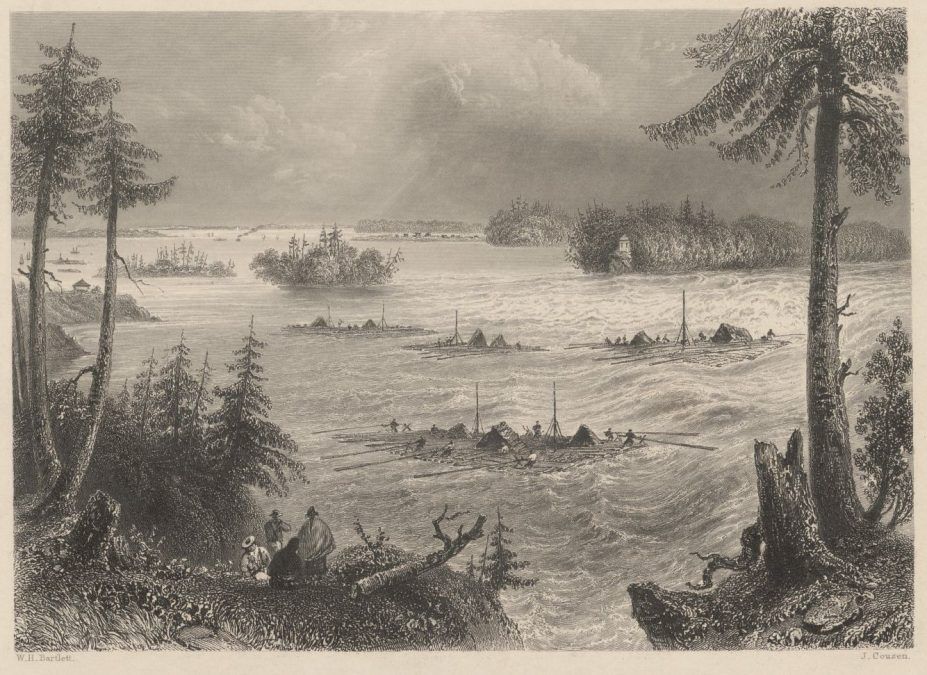By Shawn MacWha
For thousands of years the waterway that we have come to know as the Ottawa River served as a major transportation artery for the First Nations people who moved into the region following the retreat of the glaciers about 10,500 years ago. It was, however, only a little more than 400 years ago, in 1610, that Étienne Brûlé became the first European to see this beautiful part of the world. For the next two two
hundred years a steady succession of explorers, soldiers and coureurs des bois used the river as a highway to the west but settlement along its shores remained relatively sparse until well into the 19th century. Even as late as the 1830s Grenville was considered to be “the frontier” and the township had a population of only 1,450 souls. Further upstream the future capital of Canada was still just a small lumber camp named
Bytown that had only been established in 1826.
It was into this relative wilderness that famed British illustrator William Henry Bartlett travelled in the summer of 1838. Born in London in 1809 he apprenticed as an architect and soon learned his trade by making drawings of ancient buildings around England. His skill so impressed his mentor, John Britton, that as a teenager he helped to illustrate two of Britton’s most important works: “Cathedral Antiquities of England” and “Picturesque Antiquities of English Cities.” But it was soon evident that landscape was Bartlett’s passion and by the time he was a young man he was actively engaged in producing sketches and water-colours that captured the subtle beauty of the English countryside.
This was a time before photography and it was only through etchings and engravings that books could be illustrated. As a young man Bartlett combined his artistic talent with a love of adventure and he quickly started to earn a living as an illustrator of travel books. In 1832 he began a lifelong friendship with Dr. William Beattie, a popular writer of the time, and these two men soon started to collaborate on projects together. Bartlett’s wonderful illustrations complimented Beattie’s storytelling and the two of them produced a string of successful books during the 1830s including “Switzerland” in 1836 and “Scotland” in 1838.
It was through Beattie that Bartlett became friends with Nathaniel Parker Willis, a popular American writer who often associated with well known contemporaries such as Edgar Allan Poe, Henry Wadsworth Longfellow (of Evangeline fame) and Charles Dickens. In 1836 Bartlett accompanied Willis on a trip to North America and the two of them toured New England and New York, resulting in a highly acclaimed two-volume travelogue entitled “American Scenery.”
Two years later Bartlett returned across the Atlantic to visit Canada and it was during this voyage that he toured large parts of Ontario, Quebec (then still known as Upper and Lower Canada) and the Maritimes. Following this journey he again paired with Willis and the two of them produced another two-volume travel book called, appropriately enough, “Canadian Scenery” which was published in London in 1842.
Volume Two of this fascinating set includes a number of sections concerning his journey up the Ottawa River and includes a number of wonderful illustrations of that trip including drawings of the junction of the Ottawa and St. Lawrence Rivers, Oka and the Lake of the Two Mountains and numerous river scenes including one of the Chaudière Falls in Bytown.
In addition to Bartlett’s striking illustrations, the set offered its readers a comprehensive and enthusiastic view of Canada, although it should be noted that its descriptions of the First Nations are sadly reflective of the prejudices of the time. Regardless, in Europe the book was a huge hit building upon the success of “American Scenery” and together the two works cemented Bartlett’s reputation as a travel illustrator.
Indeed, speaking of “Canadian Scenery” in 1842, one British newspaper proclaimed “We have no hesitation in saying that it ranks amongst the best pictorial publications of the day.”
Bartlett returned to North America twice more during his lifetime, and also spent spent long periods sketching and writing in Europe, the Middle East and Egypt, but he never came back to Canada. Addicted to what would now be considered the call of the road his friend Beattie once wrote of him that “His destiny, however, was not to rest so long as health and activity enabled him to continue the many risks
and privations of foreign travel.”
Sadly, this prophecy proved to be true and William Bartlett died at the age of 45 aboard the sailing ship Egyptus off the coast of Malta on September 13th , 1853. Some biographers have suggested that his cause of death was cholera, but it may have been a number of other diseases of the day, or even just exhaustion from his ceaseless travels. Whatever the cause, it is only fitting that Bartlett’s body was committed to the
seas that had carried him so far around the world.
Today Bartlett’s drawings can be found in museums across the country and around the world including the National Gallery of Canada in Ottawa, the Musée national des beaux-arts in Québec, the Royal Academy of Arts in London and the American Art Museum in Washington. Affordable prints of his works, including those of what is now Ontario and Quebec, are readily available and remain as beautiful today as they were when he first captured the images. For those with the means, copies of “Canadian Scenery” can still be found from time to time, although one should expect to pay several hundred dollars for a set. Fortunately, the works can also be read for free through Google Books and almost anyone can
now turn to these works to see for themselves how Bartlett introduced the world to the beauty of the
Ottawa River.





